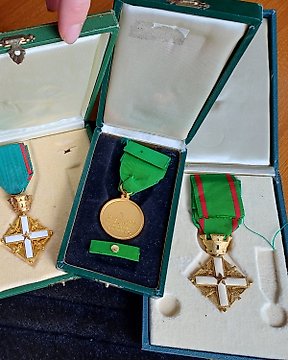Journal - The Admiralty + Giornale tedesca - 1941
Nº 83546239

États-Unis d'Amérique - Compas Lensatic M-1938 de l'armée américaine de la Seconde Guerre mondiale - fonctionnel - - Équipement militaire - 1944
Nº 83546239

États-Unis d'Amérique - Compas Lensatic M-1938 de l'armée américaine de la Seconde Guerre mondiale - fonctionnel - - Équipement militaire - 1944
Offered for auction is a very nice US Army WW2 M-1938 lensatic compass, as used by officers and lowers ranks during WW2. This version dates around 1944, see history below. It functions as it should and is in relatively good condition for its age. This compas was made by the famous super magnetio compass company and is nicely marked on the front. A very nice compass for your collection. The lens works and the compas freely moves., and the wire is present and not damaged.
Great and rare 100% original item from WW2! See also our other interesting military books and militaria for sale!
History of the The M-1938 Lensatic Compass
Undoubtedly, U. S. Army service personnel became aware of the Verner prismatic compasses while serving with their British counterparts in World War I. The Army authorized research and development projects to develop a new compass at the request of the U. S. Army’s Infantry School in Fort Benning. The first of these R&D projects for a new compass was issued on March 21, 1928. The agency responsible for the research and development of compasses for the U.S. Army, at that time, was The Engineering and Topographic Laboratories at Fort Belvoir, Virginia. Additional research projects were issued until 1938. Special Project 280 (SP-280) was authorized on October 21, 1938, to find a suitable commercial lensatic compass for the Infantry that met the Infantry School’s requirements. The Engineer Board did not discover a commercial compass that met the standards published by the Infantry School. However, two companies, The W. &L. E. Gurley Company and The Taylor Instrument Company offered to make new compass prototypes based on the Infantry School’s requirements. After the testing and modifications of their compasses, they were recommended for procurement in 1940. Both manufacturers supplied compasses to the U. S. Army during World War II. Their compasses were designated as the M-1938 Lensatic Compass.
The U. S. Army continued to suggest improvements to the M-1938 lensatic compass throughout World War II. For example, there were several attempts to solve the mechanical dampening problem with the lensatic compass. In short, they were attempting to find ways to keep the compass needle from oscillating when taking a bearing. Reducing oscillation of the needle helps to gain a more accurate reading when taking an azimuth and bearing for land navigation. A liquid was commonly used for dampening in the lensatic compasses through most of World War II. The use of liquid dampening was a better option for the technology of the times. However, experimentation with the dampening process continued throughout the war.
Vous aimerez peut-être aussi
- 16+
Cet objet a été présenté dans
Comment acheter sur Catawiki ?
1. Découvrez des objets d’exception
2. Faites la meilleure offre
3. Effectuez un paiement sécurisé






